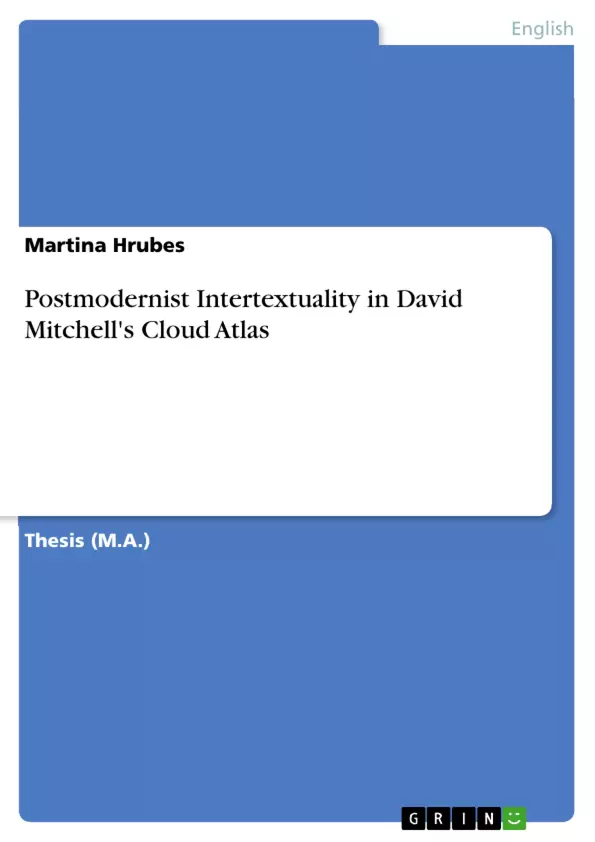The title of this study is “Postmodernist Intertextuality in David Mitchell’s Cloud Atlas” and is based on the following hypotheses:
1. There is a particular kind of intertextuality specific to postmodernist literature that differs from previous uses of intertextual references.
2. Postmodernist intertextuality is deconstructive, self-reflexive and critical of Western hegemonic discourses and metanarratives.
3. This specific kind of intertextuality is a key element of postmodernist art.
The first part of this work is going to outline some of the social and historical developments that have been associated with the postmodern condition and the rise of new art forms which respond to these changes. Lyotard’s description of postmodernity as an age that is marked by its profound “incredulity toward metanarratives” (The Postmodern Condition: A Report on Knowledge xxiv) is of particular significance to this study, especially his critique of the so-called “Enlightenment narrative” (xxiii) with its humanist values. This definition helps understand the interaction between postmodern theory and postmodernist art which are both directed against the same universalist assumptions.
In the second part of this study, the concept of postmodernist intertextuality is applied to David Mitchell's novel Cloud Atlas.
Table of Contents
- Introduction
- I Historical and Theoretical Backgrounds of Postmodernity/ Postmodernism
- The Postmodern Condition
- Challenging the Given: Deconstruction and Discourse
- Concepts of Postmodernism
- Intertextuality as Metafiction and Dialogue
- Postmodernist Intertextuality and the Politics of Representation
- II Postmodernist Intertextuality in Cloud Atlas
- Intertextual Structures and Recurring Motifs
- Framing Narratives: The Matrioshka as Structuring Principle and Metaphor
- Intertextuality as Déjà-Lu
- Fragmentation and Indeterminacy
- Making Connections: Perhaps and Accident, Perhaps an Intention
- Eternal Recurrence and the Will to Power
- Ideological Fictions: Deconstructing Generic and Narrative Conventions
- Realism, Progress and the Conception of Empire in The Pacific Journal of Adam Ewing
- Modernist Aestheticism in Letters from Zedelghem
- Paranoia and Suspense and Catharsis: Half-lives - The First Luisa Rey Mystery as Corporate Thriller
- The Ghastly Ordeal of Timothy Cavendish as Neo-Picaresque
- Metaphorising the Menace: An Orison of Sonmi~451 as Corpocratic Dystopia
- After The Fall - Post-Apocalyptic Dystopia in Sloosha's Crossin' an' Ev'rythin' After
- Intertextual Structures and Recurring Motifs
- III Conclusion: Intertextual HiStories
Objectives and Key Themes
This study analyzes the use of intertextuality in David Mitchell's novel Cloud Atlas, examining how it departs from traditional intertextual references and functions as a key element of postmodernist art. The work aims to illustrate how this specific kind of intertextuality serves as a deconstructive and self-reflexive tool, critiquing Western hegemonic discourses and metanarratives.
- Postmodernist intertextuality as a distinct feature of postmodern literature.
- The deconstructive and self-reflexive nature of postmodernist intertextuality.
- The critical function of postmodernist intertextuality in relation to Western hegemonic discourses and metanarratives.
- The role of intertextuality in the formation of postmodernist art.
- The relationship between postmodern theory and postmodernist art.
Chapter Summaries
The first part of the study explores the historical and theoretical underpinnings of postmodernity and postmodernism, tracing the emergence of new art forms that respond to the changing social and historical landscape. Lyotard's concept of "incredulity toward metanarratives" is highlighted, particularly his critique of the "Enlightenment narrative" and its humanist values. The chapter also examines the influence of post-structuralism, focusing on Foucault's discourse analysis and Derrida's theories on signification and deconstruction.
The second part delves into the use of postmodernist intertextuality in Cloud Atlas, analyzing the novel's intertextual structures and recurring motifs. It examines how these elements contribute to the narrative's overarching themes of fragmentation, indeterminacy, and the interplay of chance and intention. The chapter also explores the novel's use of the Matrioshka structure as a key organizing principle and metaphor for the interconnectedness of the narratives.
The third part examines how Cloud Atlas subverts generic and narrative conventions through intertextuality, analyzing the individual narratives in terms of their ideological underpinnings. It explores the novel's critique of realism, progress, and the conception of empire in the Pacific Journal of Adam Ewing, and its use of modernist aestheticism in Letters from Zedelghem. Additionally, the chapter analyzes the novel's portrayal of paranoia, suspense, and catharsis in Half-lives, its neo-picaresque style in The Ghastly Ordeal of Timothy Cavendish, and its depiction of corporate dystopia in An Orison of Sonmi~451.
Keywords
This study focuses on the concepts of postmodernity, postmodernism, intertextuality, deconstruction, metanarratives, Western hegemonic discourses, and the politics of representation. It also draws on the works of key figures such as Lyotard, Foucault, and Derrida, and analyzes the specific intertextual strategies employed in David Mitchell's novel Cloud Atlas.
- Quote paper
- Martina Hrubes (Author), 2008, Postmodernist Intertextuality in David Mitchell's Cloud Atlas, Munich, GRIN Verlag, https://www.grin.com/document/94473



